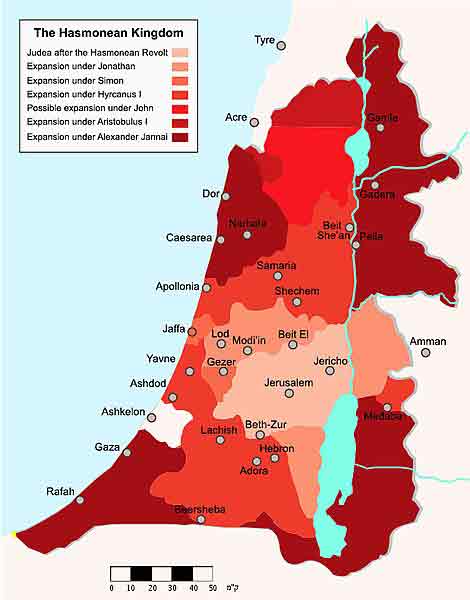
The fight against the Seleucid Empire that Mattathias had begun to protest against the stifling of the religious freedom of the Jews was led to a victorious end by Judas, Mattathias’s son. Later, the brothers and a nephew of Judas continued the fight against the Seleucids and the Hellenistic Jews both aiming for the political independence of the Jews. This fight continued for the twenty-five years that followed and finally, they succeeded at not only achieving their objective of political independence but also almost completely destroying the undesirable influences that had crept into Judaism.
The nation of the Jews was no more under any foreign rule; it was independent just like it was during the times of King David and King Solomon. By 140 BC, the ‘Hasmonean’ dynasty began ruling the Philistines and continued to do so unhindered for the next 77 years i.e. until 63 BC.
Those were the times when the Greek Empire on the whole was on the wane and its downfall did not seem far. On the other hand, things were looking up for the Roman Republic and it was gaining in strength. The Romans had begun to engage in wars with the Greeks at various places.
The Hasmonean dynasty which had established an independent Jewish state was still ruling over Jerusalem then. The Hasmonean kings held among themselves the posts of the state head, the High Priest and the army chief. The political, religious and military authority had thus consolidated in their hands. The Jewish state reached great heights of prosperity during the initial years of the Hasmonean rule, like it had during the reign of King David. During the Hasmonean period, the belief of the Jews in the concept of one supreme God was quite strong, yet cultural and social Hellenization continued unabated.

However, even the Jews who believed in God were divided into three different sects. Though among them there was absolute consensus over the concept of one supreme God, their perspectives in the matter did not quite align with one another. One particular group, the ‘Sadducees’ recognized only the written Torah. They did not believe in the concepts of the immortality of the soul, of rebirth, etc. The Sadducees mainly belonged to the upper echelons of the society and had a voice in matters of the Temple and as much as in the affairs of important religious organizations. However, the common Jewish masses resented them. Within a short while of the beginning of the AD (common) era, they were of little consequence.
The other group was the ‘Pharisees’, who believed that the written Torah was authored during the times of Moses and that the conditions since then had changed drastically. They also considered the commands that God pronounced from time to time for the Jews directly or through the medium of visionary Prophets to be part of the Torah and wanted that they be accorded importance equal to the written or documented material. They were of the opinion that the oral and the written together were the Torah and wanted that it be recognized so. They believed in the concepts of the immortality of the soul, of rebirth, etc. Eventually, the Pharisees become the majority among the Jews.
The third group, the ‘Essenes’, believed in dedicating themselves to asceticism and devoting their whole life to the worship of God and to understanding Him. They spent their time living in calm and quiet places.
Of the two groups, viz. the Sadducees and the Pharisees, the kings of the Hasmonean period favoured the one that suited their convenience and need of the time.
However, the Hasmonean dynasty that was initially committed to their people and dedicated to their interests displayed degradation on the moral front over the generations that followed. Struggles for power ensued. From 70 BC the dynasty saw growing tussles for power and the members of the ruling family engaged increasingly in plotting against each other.
The Roman rulers who were in vigorous pursuit of expansionism, of course, had their eyes on Jerusalem. Roman General Pompey, considered as one of the best military commanders in history, saw an opportunity in power struggles to capture Jerusalem.
In 63 BC, he laid siege to the city of Jerusalem. However, upon seeing the strong and impregnable fortification of the city he realized that conquering Jerusalem was not going to prove an easy task. It was the time when princes Aristobulus II and Hyrcanus II had locked horns in a conflict over the succession to the Hasmonean throne. In order to teach Aristobulus a lesson, Hyrcanus’s men secretly opened the doors of the city to General Pompey. The rivalry of the two princes had resulted in the Romans capturing the city of Jerusalem. The Roman army also entered the Holy Temple. However, on experiencing the sanctity and the serenity of the place, the Romans withdrew from the temple but also asked for reconsecrating the Temple, so says the story.
The Judea province was now under the sway of the Roman Republic.
The Romans maintained the autonomy of Judea (earlier referred as Judah) but made the Jews pay hefty amounts by way of taxes. Moreover, many of the areas of the province of Judea were annexed by the Roman Republic. Under the Roman annexation, the Jews were made to forgo their right over the coastal regions of the Mediterranean Sea. The Jews lost Samaria and many other cities too. Also, the Judean cities which were heavily Hellenized were separated from Judea and grouped together. Judea had considerably shrunk in size.
Hyrcanus was awarded for helping General Pompey and was made the High Priest.
However, the conditions in the Roman Republic changed within a few months. Pompey’sposition that had all along seemed unassailable, received a jolt. In a war with Julius Caesar, Pompey’s army was defeated, and he had to flee. Caesar then became the supreme leader of the Roman Republic. Hyrcanus had helped Caesar during his battle with Pompey.
Hyrcanus thus found favour with Julius Caesar. However, Hyrcanus was just a namesake. It was Antipater, his adviser, who actually pulled the strings. The move to side with Caesar was also planned by Antipater. As a result, Caesar appointed Antipater as the Roman Procurator of Judea instead of appointing Hyrcanus as the ruler of province.

In the later times, Antipater’s son, ‘Herod’ rebuilt and expanded the Holy Temple and hence it also came to be known as ‘Herod’s Temple’.(To be continued…)












